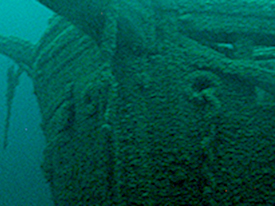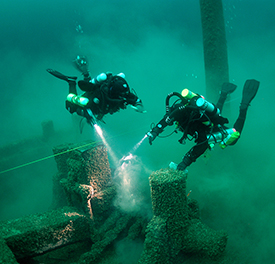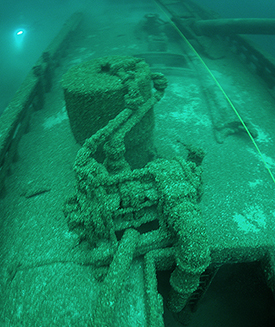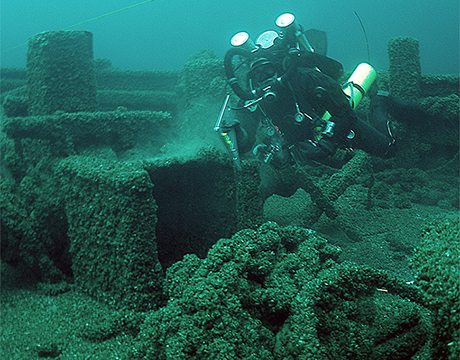
The Walter B. Allen's Final Moments
13 September 2010
By Matt Carter

View showing missing chain in the starboard hawse pipe. Large View (photograph courtesy of Tamara Thomsen).

Divers examine spike driven into the windlass. Large View (photograph courtesy of Tamara Thomsen).
On Sunday, April 11, 1880, the Walter B. Allen went ashore on South Manitou Island at the north end of Lake Michigan in a storm. During the stranding the Walter B. Allen lost her large anchor and her mainsail. The vessel was loaded with 19,000 bushels of corn from Chicago to Buffalo. The tug Caroline Williams was brought from Manistee, Michigan to release the ship. A steam pump was placed on her deck and she was taken in tow to Milwaukee for repairs. While in tow between Manitowoc and Sheboygan, Wisconsin, a snow storm picked up and pushed waves over the ship, filling her to the rail and extinguishing the fires of the pump. The Walter B. Allen sunk within 20 minutes of taking on water, but the tug was able to rescue all aboard.
Our survey and mapping of the shipwreck site revealed evidence consistent with this history. Although one of the anchors is known to have been recovered from the ship by salvors in the early 1970’s, they noted that there was only one anchor present at the time of the wreck’s discovery. The starboard side chain is missing from the hawse pipe and much of the ship’s anchor chain remains piled on the deck. The windlass shows evidence of being stopped with a spike driven into the barrel.

View of salvage pump with donkey boiler extending into the forward hold. Large View (photograph courtesy of Tamara Thomsen).
The big salvage pump, with donkey boiler and hawser remains on deck. The pipe extends into the forward hold and the discharge pipe is directed over the starboard side of the ship. Historic newspapers report the value of the pump apparatus was $4000 in 1880 and the loss of the pump was the liability of the ship’s owner, John Long of Chicago.
During our survey of the Walter B. Allen we were able to distinguish many of the vessel’s features which are unique to canallers. Her lines are boxy, with a very bluff bow and a square stern. Her davits at the stern are folded, retracted forward as they would be to transit the canal locks. The vessel’s jib boom is retractable, and her bowsprit appears to be constructed in a manner to be disconnected from the samson post and possibly pulled on to the deck. Up until 2007 both masts were upright and standing with tops in place. Sometime during that summer, local divers placed a temporary mooring to the top of the mainmast and a large charter boat cracked off the mast tenon and toppled the mast during heavy weather. The mainmast has now heaved the deck and lies across the portside rail.
The Walter B. Allen site presented us with a number of challenges however, through the use of closed circuit rebreathers and with a team of dedicated and highly skilled volunteers this project has shown that archaeological data can be gathered in challenging environments to provide us with further insights into our maritime past.

Diver examines wreckage on deck. Large View (Photograph courtesy of Tamara Thomsen).
Return to MUA Project Journals home page.

